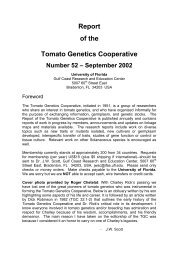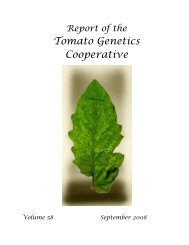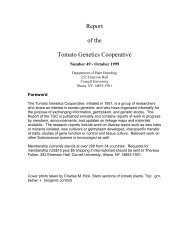Volume 60 - Tomato Genetics Cooperative - University of Florida
Volume 60 - Tomato Genetics Cooperative - University of Florida
Volume 60 - Tomato Genetics Cooperative - University of Florida
Create successful ePaper yourself
Turn your PDF publications into a flip-book with our unique Google optimized e-Paper software.
Literature cited<br />
1. Acosta J.C., 1963. Genetic analysis <strong>of</strong> bacterial wilt resistance and certain other<br />
characters in a tomato cross Lycopersicon esculentum Mill. and L. pimpinellifolium<br />
Mill. PhD Thesis, <strong>University</strong> <strong>of</strong> Hawaii (Agriculture, Plant Pathology). On line<br />
accessible at:<br />
http://scholarspace.manoa.hawaii.edu/bitstream/10125/11673/2/uhm_phd_6402645<br />
_r.pdf<br />
2. Acosta, J., Gilbert, J., and Quinon, V.L., 1964. Heritability <strong>of</strong> bacterial wilt resistance<br />
in tomato. Proceedings <strong>of</strong> the American Society for Horticultural Science 84:455-<br />
461.<br />
3. Anaïs G., 1986. Utilisation de la résistance variétale dans la lutte contre le<br />
flétrissement bactérien de la tomate Pseudomonas solanacearum E.F. Smith. Bull.<br />
Tech. D‟Information 409/411 : 449-452.<br />
4. Anaïs G., 1997. La tomate. Pp 591-<strong>60</strong>5 In : L‟Amélioration des Plantes tropicales. A.<br />
Charrier, M. Jacquot, S. Hamon, D. Nicolas (Sc. Eds), Ed. CIRAD, ORSTOM..<br />
5. Anais G., pers. com. 2010.<br />
6. Ano G., Anaïs G., Marival P., 2002. Création de variétés de tomate résistantes à<br />
Ralstonia solanacearum et PYMV, adaptées aux régions tropicales. Proceedings <strong>of</strong><br />
the XXXVIII th Meeting <strong>of</strong> the Carribean Food Crops Society, Martinique : 234-238.<br />
7. Ano G., Anaïs G., Marival P., Chidiac A., 2004. L‟amélioration de la tomate pour les<br />
régions tropicales de plaine: travaux en Guadeloupe. Les familles CRAPY associent<br />
les résistances aux Bégomovirus PYMV et TYLCV à la résistance au Ralstonia<br />
solanacearum (race 1). Phytoma, la défense des végétaux 573 : 23-25.<br />
8. AVRDC Report 1998. Asian Vegetables Research and Development Center,<br />
Taiwan.<br />
9. Azzam H., 1964. <strong>Tomato</strong> breeding for the tropics. Proc. <strong>of</strong> the 2 nd Annual Meeting <strong>of</strong><br />
the Caribbean Food Crops Society, Bridgetown, Barbados 2: 56-59.<br />
10. Balatero, C. H., and Hautea, D. M. 2001. Identification <strong>of</strong> AFLP and RGA markers<br />
associated with bacterial wilt resistance QTL derived from tomato Lycopersicon<br />
pimpinellifolium. p.225-243 in Solanaceae V: advances in taxonomy and utilization,<br />
edited by R. G. van den Berg, G. W. M. Barendse, G. M. van der Weerden and C.<br />
Mariani. Nijmegen <strong>University</strong> Press.<br />
11. Balatero C.H., Hautea D.M., Narciso J.O., Hanson P.M., 2005. QTL mapping for<br />
bacterial wilt resistance in Hawaii 7996 using AFLP, RGA and SSR markers. Pp<br />
301-308 In: Bacterial wilt: the disease and the Ralstonia solanacearum complex. C.<br />
Allen, P. Prior, A.C. Hayward (Sc. Eds), American Phytopathological Society (APS),<br />
St Paul, USA.<br />
12. Barham W.S. Ellis D.E., 1951. Sources <strong>of</strong> resistance to late blight and bacterial wilt.<br />
Rept. <strong>Tomato</strong> Genet. Coop. 1: 2.<br />
13. Borchers E.A.,Nevin C.S., 1954. Quantitative estimation <strong>of</strong> a bitter principle in<br />
tomato. Proc. Amer. Soc. Hort. Sci. 63:420-426.<br />
14. Cardoso, S. C.; Soares, A. C. F.; Brito, A. dos S.; Carvalho, L. A. de; Ledo, C. A. da<br />
S., 2006. Potential <strong>of</strong> Hawaii 7996 hybrid as rootstock for tomato cultivars. Bragantia<br />
65(1): 89-96.<br />
23





